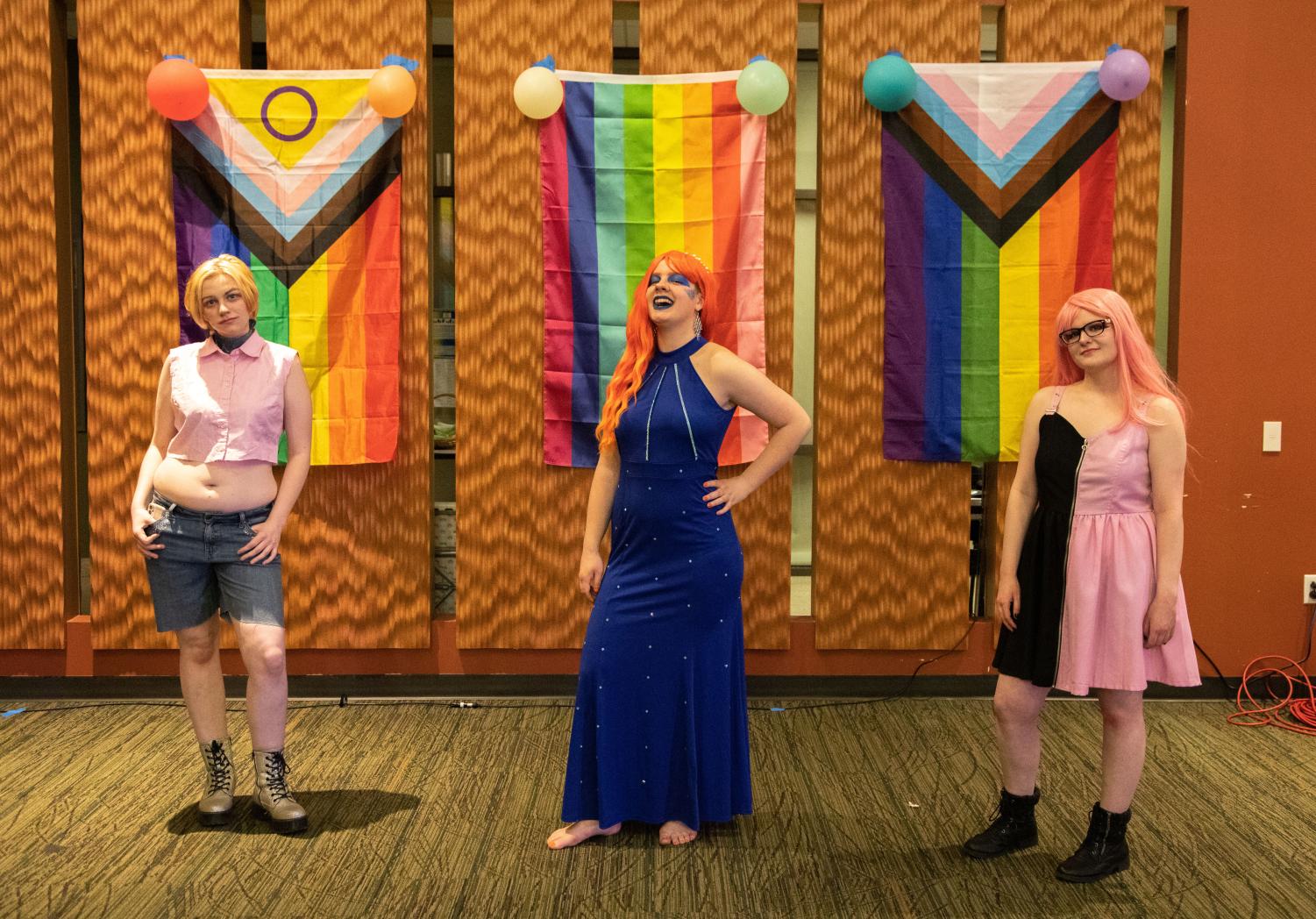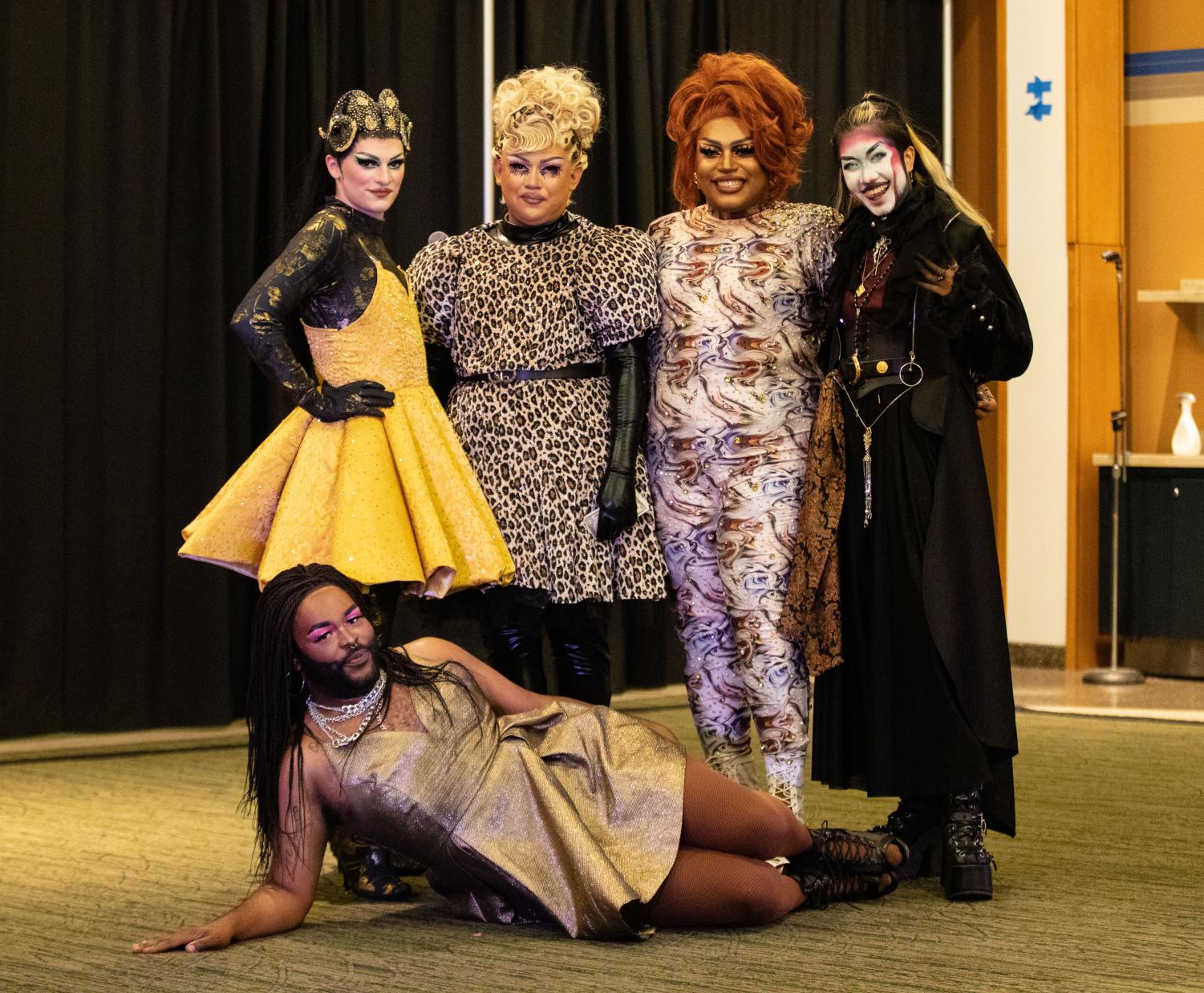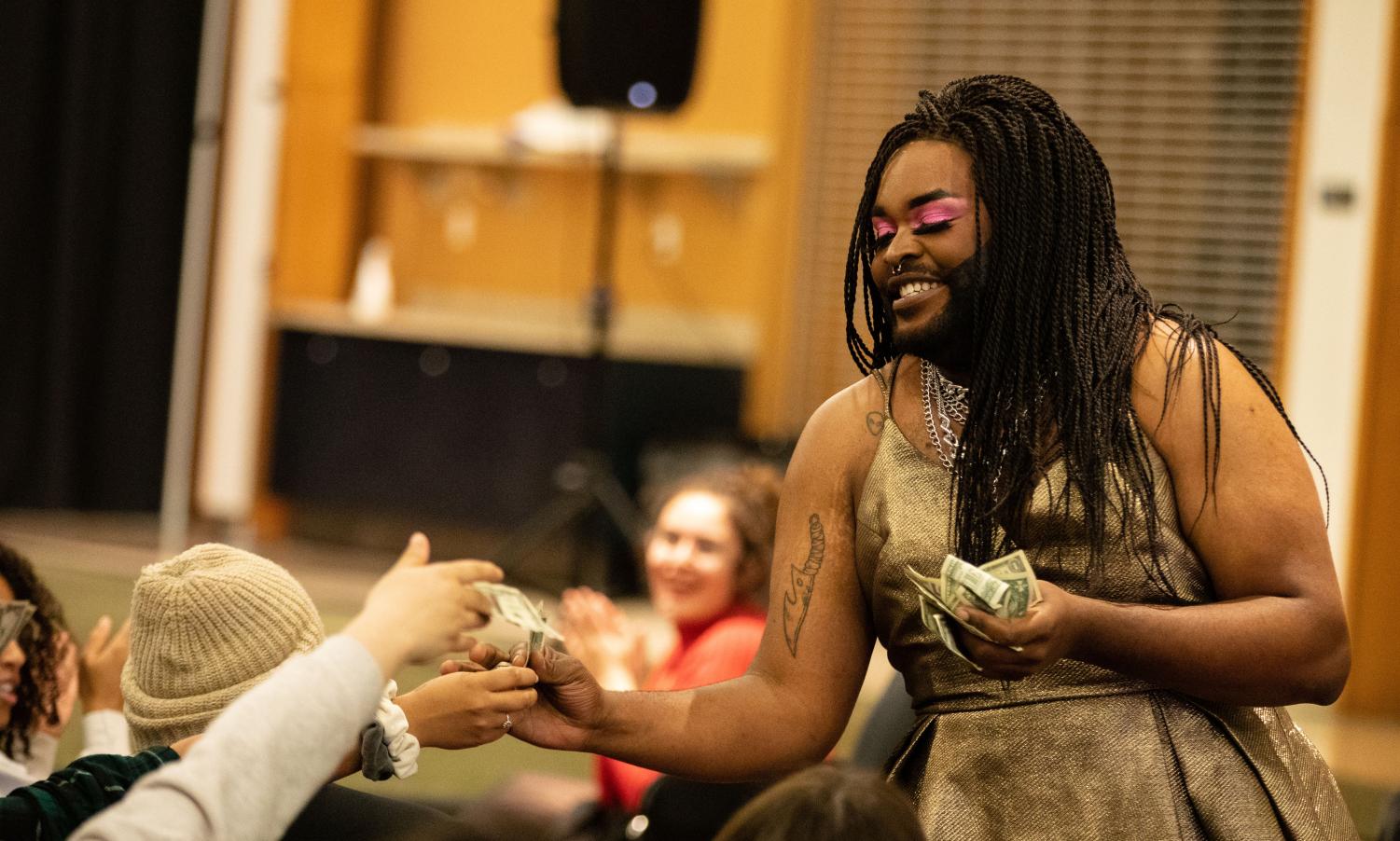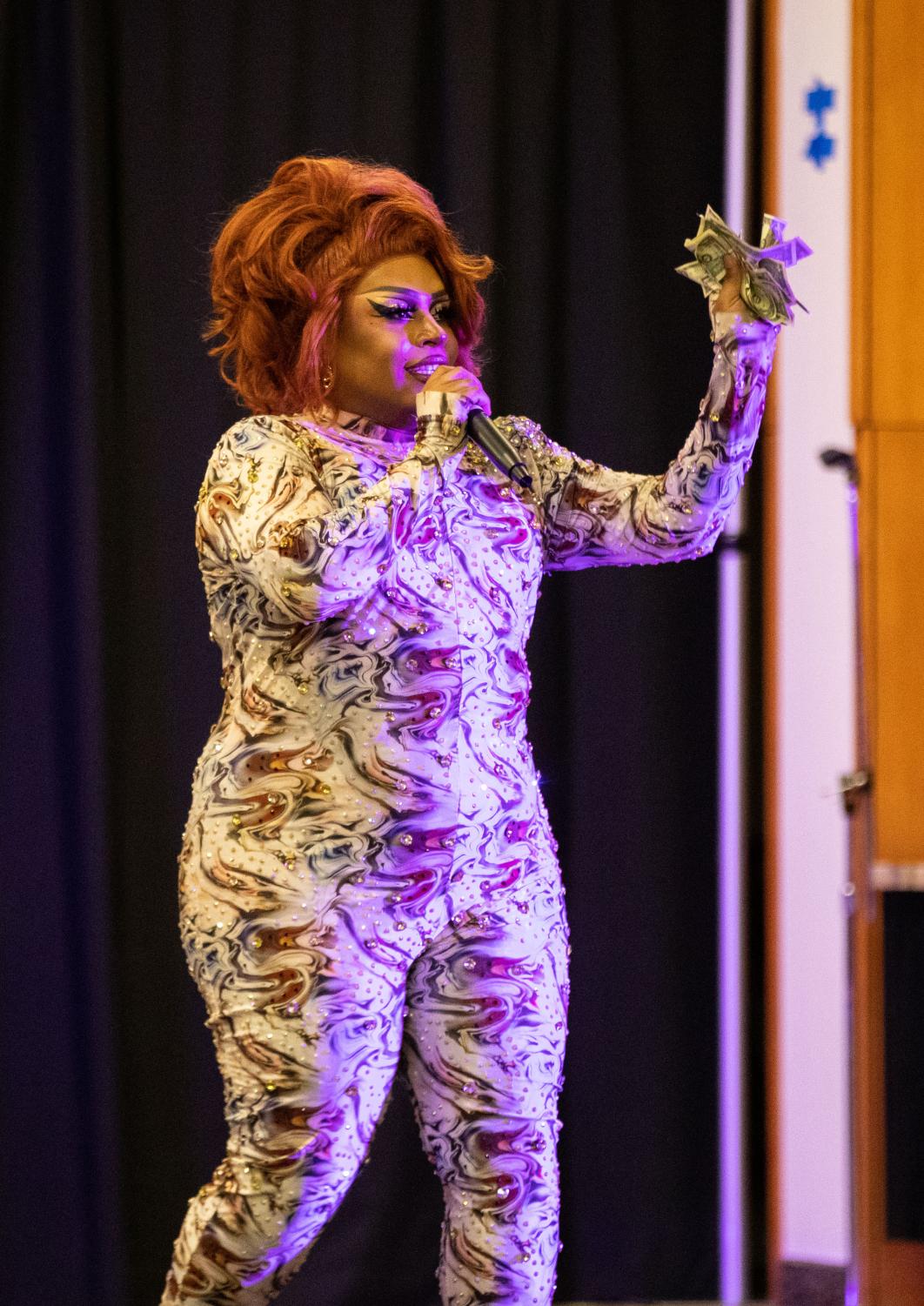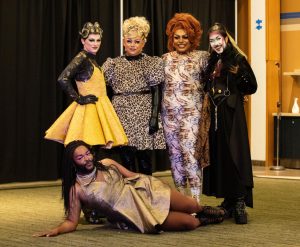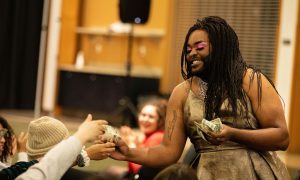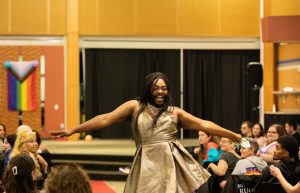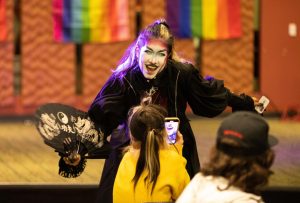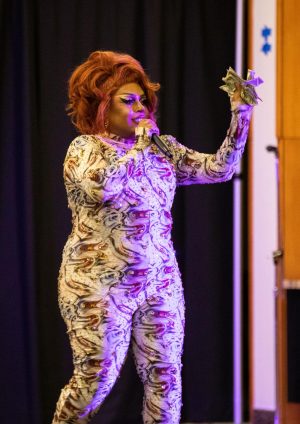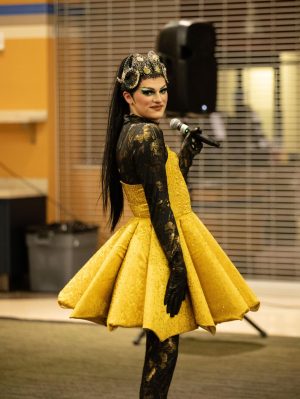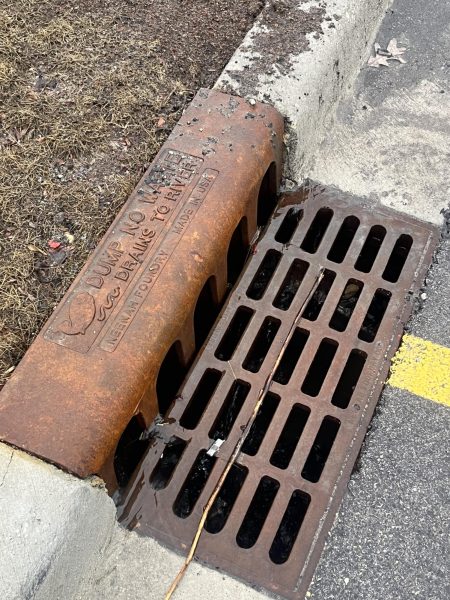“You can be whomever or whatever you want”: SWANS hosts drag show
Crowds of people looked on in a mix of shock and amusement as a woman in a short, skin-tight dress saunters toward a married couple. When she closes the distance, the two greet her with a chuckle; she, in turn, treats the husband to a lap dance. The tension bubbling in the audience bursts into laughter that almost drowns out the thrumming music, and they meet the spectacle with outstretched hands and dollar bills.
Though these activities are far from the standard fare at Elgin Community College, they were part of the drag shows hosted by student-led group Students Who Are Not Silent (SWANS) on Friday, April 21 in the Jobe Lounge. This event marked the fifth drag show hosted by the group, as well as the first show to embrace student performers. Second-year ECC student Maddy Fraser—who debuted under the drag name Miss Dreavus—found their foray exhilarating.
“I was so nervous that I would look silly performing,” Fraser said, “but the energy from the crowd and the other queens made my performance an unforgettable event.”
Though performing in drag was “extremely fun” for Fraser, that wasn’t all there was to it—drag also gave them space to play around with aspects of their gender.
“As a non-binary person, expressing myself through clothes and makeup is essential to how I like to present, and drag was no different,” Fraser said. “It gave me an outlet to further explore that concept of gender presentation. Drag was surprisingly kind to my gender dysphoria. I’ve always been super dysphoric about my chest and being referred to as ‘she’, but in the context of drag it didn’t bother me.”
Drag—as with any other art form—can be as meaningful as it is fun, according to Fraser. And, as Fraser’s case illustrates, the artform can be particularly welcoming to queer people, with its subversion of gender norms appealing to a group that has historically been punished for the ways in which they engage with gender; a truth that Jovan Williams—who performs under the name Lady Deviant—can attest to.
“Anytime someone is in drag, it’s a public statement,” Williams said. “Especially when you’re big and hairy and Black like me.”
Lady Deviant—who dons a beard and full face of makeup in her performances— is a persona trying to make a public statement: a rejection of the gender binaries that can be especially constricting for queer people of color. In a society that tends to hyper-masculinize Black men and hyper-feminize gay men, the ability to blur the lines between the two extremes can prove liberating, even empowering.
Drag can be emboldening in many other ways, however, according to Williams.
“One thing I struggle with is asking for help and making my voice be heard,” Williams said. “Drag performers are freelance artists; a lot of the time, your bookings are things you went out and asked for, so if you want to make a name for yourself—or a career—you kind of have to get it yourself.”
Drag—according to Williams—is a demanding artform: beyond requiring performers to dance, serve looks, and engage an audience, queens must develop the interpersonal skills to advocate for themselves all the while. This—combined with the rejection performers are likely to come across at some point in their careers—-forges a sense of resilience and even confidence amongst queens.
Such is also the case for Videl Gonzales, who adopts the “suave and sexy” stage persona Spade Slick in their performances.
“When I am in the light, people are seeing Spade, not me,” Gonzales said. “And I know that Spade is always confident.”
Gonzales—who was shy going into the drag scene—found that their persona gave them the personal distance they needed to abandon their insecurities out of drag. Likewise, these personas can allow performers to explore parts of themselves that may otherwise be hidden away, according to Gonzales.
“Drag, to me, is an artistic extension of yourself,” Gonzales said. “[My persona] portrays a part of me that people don’t often get to see, a piece of the bigger picture.”
On the surface, the idea that donning a persona allows someone to be more authentic to themselves may seem counterintuitive. However, drag, is just another form of communication, according to the peformers. And for many—like Gonzales—art’s subjective nature allows people to convey truths about themselves which are otherwise hard to articulate with words. To then broadcast these truths to the public makes drag an empowering form of self expression, as Nestor Ramos—who performs as Tory Chiffon—would agree.
“It [drag] is such a free form of self expression to be yourself in society that, many times, wants to control what we are allowed to be,” Ramos said. “It is a public statement that no matter what society does to try to erase people’s identities, we will continue to be free and visible.”
Ramos’s sentiments ring particularly pertinent amidst a slew of anti-LGBTQ legislation, which seek to subjugate the very queer performers who have built the drag scene. For these creators, drag provides what is an increasingly rare opportunity to make themselves heard and known. And, as Ramos notes, drag is a particularly effective means to that end.
“Rarely does an artist ever get to be completely in charge of what they get to show an audience,” Ramos said. “I think that’s the beauty of drag: you can be whoever or whatever you want and you get to show it exactly how you want it to be seen.”
To that end—that is, self-expression—Ramos works tirelessly; that she spent “over 60 hours stoning 40,000 stones to [her] dress” speaks to the lengths that she—and many other drag queens—might go to ensure they are presenting themselves at their best.
And, as Nestor’s partner and fellow drag performer Jeremy Gavin—also known as Jakki Love—observes, this level of dedication can manifest when feeling unwanted.
“If you don’t feel respected and loved, it really pushes you harder to love yourself and work even harder to thrive,” Gavin said.
Drag—as a queer performance art—often brings in artists who have been maligned for who or what they are; who have been told they are defective or inadequate, according to the performers. There is a power, then, in drag’s ability to bring its practitioners not just a sense of competency, but prosperity; that being oneself is enough to enrapture an audience.
“For me, it [drag] really is an escape from the real world,” Nestor said. “Having all the power in the world for the next ‘X’ amount of minutes is always so thrilling.”
And, according to the performers, it is fun.
“We all [just] wanna look good and have a good time,” said Lady Deviant.

Hello! I'm Vick, a sophomore at ECC, and this is my first year working with the Observer. I'm currently pursuing a double major in English and Psychology....
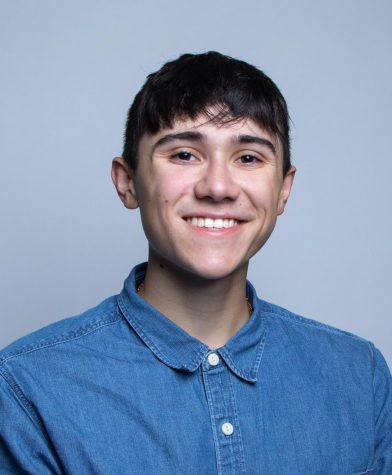
I'm Dominic Di Palermo. I'm the Editor-in-Chief of the Observer. This is my second year at Elgin Community College and my second year with The Observer....




